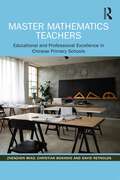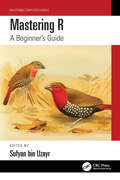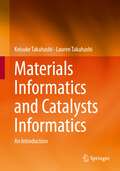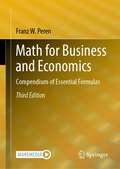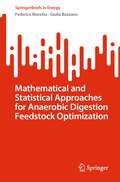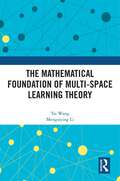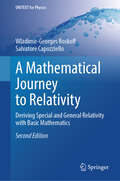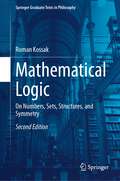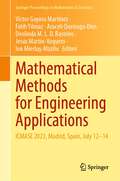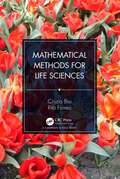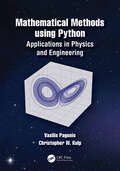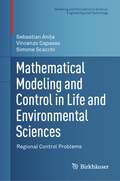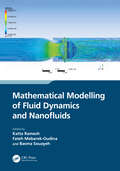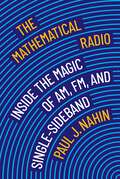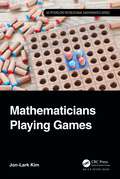- Table View
- List View
Master Mathematics Teachers: Educational and Professional Excellence in Chinese Primary Schools
by Zhenzhen Miao Christian Bokhove David ReynoldsThis practical guide invites teachers to take a journey towards masterly mathematics teaching using the experiences and lessons learnt across five Chinese provinces, Anhui, Beijing, Jiangsu, Jiangxi and Tianjin.On this journey, you will gain a thorough understanding of: (1) the quality and characteristics of master mathematics teachers’ teaching, (2) the quality of mathematics learning they have nurtured amongst their students in affective, metacognitive and cognitive dimensions and (3) the teaching-learning mechanisms that underpin excellent performance in the three dimensions. Alongside the quantitative and qualitative evidence on educational excellence, you will also delve deep into the trajectories and processes of professional development that generate professional excellence amongst master mathematics teachers and their peers within and across primary schools, up and down China.Building on data collected with 70 master mathematics teachers and 3,178 students and from teaching research events at the school, municipal, provincial and national levels, the Master Mathematics Teachers (MasterMT) project is, to date, the first that has looked at the legendary tribe of master mathematics teachers in China at such a large scale, and with such breadth and depth. The book offers invaluable insights for any teacher or teacher educator who wants to improve mathematics teaching and learning and generate educational and professional excellence in primary schools and beyond.More information on the Master Mathematics Teachers (MasterMT) project can be accessed at https://mastermt.org/.
Mastering R: A Beginner's Guide (Mastering Computer Science)
R is a statistical computing and graphics programming language that you can use to clean, analyze, and graph data. It is widely used by researchers from various disciplines to estimate and display results and by teachers of statistics and research methods. This book is a detailed guide for beginners to understand R with an explanation of core statistical and research ideas. One of the powerful characteristics of R is that it is open-source, which means that anyone can access the underlying code used to run the program and add their own code for free. It will always be able to perform the latest statistical analyses as soon as anyone thinks of them. R corrects mistakes quickly and transparently and has put together a community of programming and statistical experts that you can turn to for help. Mastering R: A Beginner’s Guide not only explains how to program but also how to use R for visualization and modeling. The fundamental principles of R explained here are helpful to beginner and intermediate users interested in learning this highly technological and diverse language.
Mastering R: A Beginner's Guide (Mastering Computer Science)
by Sufyan Bin UzayrR is a statistical computing and graphics programming language that you can use to clean, analyze, and graph data. It is widely used by researchers from various disciplines to estimate and display results and by teachers of statistics and research methods. This book is a detailed guide for beginners to understand R with an explanation of core statistical and research ideas. One of the powerful characteristics of R is that it is open-source, which means that anyone can access the underlying code used to run the program and add their own code for free. It will always be able to perform the latest statistical analyses as soon as anyone thinks of them. R corrects mistakes quickly and transparently and has put together a community of programming and statistical experts that you can turn to for help. Mastering R: A Beginner’s Guide not only explains how to program but also how to use R for visualization and modeling. The fundamental principles of R explained here are helpful to beginner and intermediate users interested in learning this highly technological and diverse language.
Materials Data Science: Introduction to Data Mining, Machine Learning, and Data-Driven Predictions for Materials Science and Engineering (The Materials Research Society Series)
by Stefan SandfeldThis text covers all of the data science, machine learning, and deep learning topics relevant to materials science and engineering, accompanied by numerous examples and applications. Almost all methods and algorithms introduced are implemented “from scratch” using Python and NumPy. The book starts with an introduction to statistics and probabilities, explaining important concepts such as random variables and probability distributions, Bayes’ theorem and correlations, sampling techniques, and exploratory data analysis, and puts them in the context of materials science and engineering. Therefore, it serves as a valuable primer for both undergraduate and graduate students, as well as a review for research scientists and practicing engineers. The second part provides an in-depth introduction of (statistical) machine learning. It begins with outlining fundamental concepts and proceeds to explore a variety of supervised learning techniques for regression and classification, including advanced methods such as kernel regression and support vector machines. The section on unsupervised learning emphasizes principal component analysis, and also covers manifold learning (t-SNE and UMAP) and clustering techniques. Additionally, feature engineering, feature importance, and cross-validation are introduced. The final part on neural networks and deep learning aims to promote an understanding of these methods and dispel misconceptions that they are a “black box”. The complexity gradually increases until fully connected networks can be implemented. Advanced techniques and network architectures, including GANs, are implemented “from scratch” using Python and NumPy, which facilitates a comprehensive understanding of all the details and enables the user to conduct their own experiments in Deep Learning.
Materials Informatics and Catalysts Informatics: An Introduction
by Keisuke Takahashi Lauren TakahashiThis textbook is designed for students and researchers who are interested in materials and catalysts informatics with little to no prior experience in data science or programming languages. Starting with a comprehensive overview of the concept and historical context of materials and catalysts informatics, it serves as a guide for establishing a robust materials informatics environment. This essential resource is designed to teach vital skills and techniques required for conducting informatics-driven research, including the intersection of hardware, software, programming, machine learning within the field of data science and informatics. Readers will explore fundamental programming techniques, with a specific focus on Python, a versatile and widely-used language in the field. The textbook explores various machine learning techniques, equipping learners with the knowledge to harness the power of data science effectively. The textbook provides Python code examples, demonstrating materials informatics applications, and offers a deeper understanding through real-world case studies using materials and catalysts data. This practical exposure ensures readers are fully prepared to embark on their informatics-driven research endeavors upon completing the textbook. Instructors will also find immense value in this resource, as it consolidates the skills and information required for materials informatics into one comprehensive repository. This streamlines the course development process, significantly reducing the time spent on creating course material. Instructors can leverage this solid foundation to craft engaging and informative lecture content, making the teaching process more efficient and effective.
Math for Business and Economics: Compendium of Essential Formulas
by Franz W. PerenThis 3rd edition revised and extended compendium contains and explains essential mathematical formulas within an economic context. Newly added content introduces the mathematical practical application of optimization by using the Lagrange function, presenting the issue of linear optimization cases where the relative extremes (minima or maxima) of a linear (target) function can be determined under restrictive linear constraint and its relevance for business management practice. A broad range of aids and supportive examples will help readers to understand the formulas and their practical applications. This mathematical formulary is presented in a practice-oriented, clear, and understandable manner, as it is needed for meaningful and relevant application in global business, as well as in the academic setting and economic practice. The topics presented include but are not limited to mathematical signs and symbols, logic, arithmetic, algebra, linear algebra, combinatorics, and financial mathematics, including an international comparison between different national methods used in the calculation of interest, optimization of linear models, functions, differential calculus, integral calculus, elasticities, annuity calculation, economic functions, and the Peren Theorem.Given its scope, the book offers an indispensable reference guide and is a must-read for undergraduate and graduate students, as well as managers, scholars, and lecturers in business, politics, and economics.
Mathematical and Statistical Approaches for Anaerobic Digestion Feedstock Optimization (SpringerBriefs in Energy)
by Federico Moretta Giulia BozzanoThis book examines biomass mixture modeling and optimization. The book discusses anaerobic digestion and related fermentative processes and explains their compositional dynamics. Early chapter examine macromolecules, elemental fractions, and their direct influence on methane production. Supported by an extensive data bank of substrates obtained from research, the book points out correlations that enable the estimation of global methane production for diverse biomass mixtures. Furthermore, it provides valuable insights into discerning the optimal composition capable of yielding the utmost methane output.The book integrates cutting-edge machine learning techniques and shows how the programming language Python and Julia can be used for analysis and to optimize processes. It has many graphs, figures, and visuals.
The Mathematical Foundation of Multi-Space Learning Theory
by Tai Wang Mengsiying LiThis book explores the measurement of learning effectiveness and the optimization of knowledge retention by modeling the learning process and building the mathematical foundation of multi-space learning theory.Multi-space learning is defined in this book as a micro-process of human learning that can take place in more than one space, with the goal of effective learning and knowledge retention. This book models the learning process as a temporal sequence of concept learning, drawing on established principles and empirical evidence. It also introduces the matroid to strengthen the mathematical foundation of multi-space learning theory and applies the theory to vocabulary and mathematics learning, respectively. The results show that, for vocabulary learning, the method can be used to estimate the effectiveness of a single learning strategy, to detect the mutual interference that might exist between learning strategies, and to predict the optimal combination of strategies. In mathematical learning, it was found that timing is crucial in both first learning and second learning in scheduling optimization to maximize the intersection effective interval.The title will be of interest to researchers and students in a wide range of areas, including educational technology, learning sciences, mathematical applications, and mathematical psychology.
The Mathematical Foundation of Multi-Space Learning Theory
by Tai Wang Mengsiying LiThis book explores the measurement of learning effectiveness and the optimization of knowledge retention by modeling the learning process and building the mathematical foundation of multi-space learning theory.Multi-space learning is defined in this book as a micro-process of human learning that can take place in more than one space, with the goal of effective learning and knowledge retention. This book models the learning process as a temporal sequence of concept learning, drawing on established principles and empirical evidence. It also introduces the matroid to strengthen the mathematical foundation of multi-space learning theory and applies the theory to vocabulary and mathematics learning, respectively. The results show that, for vocabulary learning, the method can be used to estimate the effectiveness of a single learning strategy, to detect the mutual interference that might exist between learning strategies, and to predict the optimal combination of strategies. In mathematical learning, it was found that timing is crucial in both first learning and second learning in scheduling optimization to maximize the intersection effective interval.The title will be of interest to researchers and students in a wide range of areas, including educational technology, learning sciences, mathematical applications, and mathematical psychology.
A Mathematical Journey to Relativity: Deriving Special and General Relativity with Basic Mathematics (UNITEXT for Physics)
by Wladimir-Georges Boskoff Salvatore CapozzielloThe 2nd edition of this textbook features more than 100 pages of new material, including four new chapters, as well as an improved discussion of differential geometry concepts and their applications. The textbook aims to provide a comprehensive geometric description of Special and General Relativity, starting from basic Euclidean geometry to more advanced non-Euclidean geometry and differential geometry. Readers will learn about the Schwarzschild metric, the relativistic trajectory of planets, the deflection of light, the black holes, and the cosmological solutions like de Sitter, Friedman-Lemaître-Robertson-Walker, and Gödel ones, as well as the implications of each of them for the observed physical world. In addition, the book provides step-by-step solutions to problems and exercises, making it an ideal introduction for undergraduate students and readers looking to gain a better understanding of Special and General Relativity. In this new edition, a wide discussion on metric-affine theories of gravity and equivalent formulations of General Relativity is reported. The aim is presenting also topics which could be useful for PhD students and researchers studying General Relativity from an advanced point of view.
Mathematical Logic: On Numbers, Sets, Structures, and Symmetry (Springer Graduate Texts in Philosophy #4)
by Roman KossakThis textbook is a second edition of the successful, Mathematical Logic: On Numbers, Sets, Structures, and Symmetry. It retains the original two parts found in the first edition, while presenting new material in the form of an added third part to the textbook. The textbook offers a slow introduction to mathematical logic, and several basic concepts of model theory, such as first-order definability, types, symmetries, and elementary extensions. Part I, Logic Sets, and Numbers, shows how mathematical logic is used to develop the number structures of classical mathematics. All necessary concepts are introduced exactly as they would be in a course in mathematical logic; but are accompanied by more extensive introductory remarks and examples to motivate formal developments. The second part, Relations, Structures, Geometry, introduces several basic concepts of model theory, such as first-order definability, types, symmetries, and elementary extensions, and shows how they are usedto study and classify mathematical structures. The added Part III to the book is closer to what one finds in standard introductory mathematical textbooks. Definitions, theorems, and proofs that are introduced are still preceded by remarks that motivate the material, but the exposition is more formal, and includes more advanced topics. The focus is on the notion of countable categoricity, which analyzed in detail using examples from the first two parts of the book. This textbook is suitable for graduate students in mathematical logic and set theory and will also be of interest to mathematicians who know the technical aspects of the subject, but are not familiar with its history and philosophical background.
Mathematical Methods for Engineering Applications: ICMASE 2023, Madrid, Spain, July 12–14 (Springer Proceedings in Mathematics & Statistics #439)
by Víctor Gayoso Martínez Fatih Yilmaz Araceli Queiruga-Dios Deolinda M. L. D. Rasteiro Jesús Martín-Vaquero Ion Mierluş-MaziluThese proceedings gather selected, peer-reviewed papers presented at the IV International Conference on Mathematics and its Applications in Science and Engineering – ICMASE 2023, held on July 12–14, 2023 by the University Center of Technology and Digital Arts (U-tad) in Madrid, Spain.Papers in this volume cover new developments in applications of mathematics in science and engineering, with an emphasis on mathematical and computational modeling of real-world problems. Topics range from the use of differential equations to model mechanical structures to the employ of number theory in the development of information security and cryptography. Educational issues specific to the acquisition of mathematical competencies by engineering and science students at all university levels are also touched on.Researchers, practitioners, and university students can significantly benefit from this volume, especially those seeking advanced methods for applying mathematics to various contexts and fields.
Mathematical Methods for Life Sciences
by Cinzia Bisi Rita FioresiMathematical Methods for Life Sciences introduces calculus, and other key mathematical methods, to students from applied sciences (biology, biotechnology, chemistry, pharmacology, material science, etc). Special attention is paid to real-world applications, and for every concept, many concrete examples are provided. The book does not aim to enable students to prove theorems and construct elaborate proofs, but rather to leave students with a clear understanding of the practical mathematics behind the power of optimization, dynamical systems, and all the predictive tools these theories give rise to.Features No prerequisites beyond high school algebra and geometry Could serve as the primary text for a first-year course in mathematical methods for biology, biotechnology, or other life sciences Easy to read: the students may skip all the proofs and go directly to key examples and applications Cinzia Bisi is a professor of Geometry at the Department of Mathematics and Computer Sciences at the University of Ferrara, Italy. She has wide experience in teaching mathematics and statistics to students in the Department of Life Sciences. She has an interest in the areas of pure and applied mathematics. Rita Fioresi is a professor of Geometry at the FaBiT Department at the University of Bologna, Italy. She has written textbooks in linear algebra, and her research interests are primarily in the areas of pure and applied mathematics. .
Mathematical Methods for Life Sciences
by Cinzia Bisi Rita FioresiMathematical Methods for Life Sciences introduces calculus, and other key mathematical methods, to students from applied sciences (biology, biotechnology, chemistry, pharmacology, material science, etc). Special attention is paid to real-world applications, and for every concept, many concrete examples are provided. The book does not aim to enable students to prove theorems and construct elaborate proofs, but rather to leave students with a clear understanding of the practical mathematics behind the power of optimization, dynamical systems, and all the predictive tools these theories give rise to.Features No prerequisites beyond high school algebra and geometry Could serve as the primary text for a first-year course in mathematical methods for biology, biotechnology, or other life sciences Easy to read: the students may skip all the proofs and go directly to key examples and applications Cinzia Bisi is a professor of Geometry at the Department of Mathematics and Computer Sciences at the University of Ferrara, Italy. She has wide experience in teaching mathematics and statistics to students in the Department of Life Sciences. She has an interest in the areas of pure and applied mathematics. Rita Fioresi is a professor of Geometry at the FaBiT Department at the University of Bologna, Italy. She has written textbooks in linear algebra, and her research interests are primarily in the areas of pure and applied mathematics. .
Mathematical Methods using Python: Applications in Physics and Engineering
by Vasilis Pagonis Christopher Wayne KulpThis advanced undergraduate textbook presents a new approach to teaching mathematical methods for scientists and engineers. It provides a practical, pedagogical introduction to utilizing Python in Mathematical and Computational Methods courses. Both analytical and computational examples are integrated from its start. Each chapter concludes with a set of problems designed to help students hone their skills in mathematical techniques, computer programming, and numerical analysis. The book places less emphasis on mathematical proofs, and more emphasis on how to use computers for both symbolic and numerical calculations. It contains 182 extensively documented coding examples, based on topics that students will encounter in their advanced courses in Mechanics, Electronics, Optics, Electromagnetism, Quantum Mechanics etc.An introductory chapter gives students a crash course in Python programming and the most often used libraries (SymPy, NumPy, SciPy, Matplotlib). This is followed by chapters dedicated to differentiation, integration, vectors and multiple integration techniques. The next group of chapters covers complex numbers, matrices, vector analysis and vector spaces. Extensive chapters cover ordinary and partial differential equations, followed by chapters on nonlinear systems and on the analysis of experimental data using linear and nonlinear regression techniques, Fourier transforms, binomial and Gaussian distributions. The book is accompanied by a dedicated GitHub website, which contains all codes from the book in the form of ready to run Jupyter notebooks. A detailed solutions manual is also available for instructors using the textbook in their courses.Key Features:· A unique teaching approach which merges mathematical methods and the Python programming skills which physicists and engineering students need in their courses.· Uses examples and models from physical and engineering systems, to motivate the mathematics being taught.· Students learn to solve scientific problems in three different ways: traditional pen-and-paper methods, using scientific numerical techniques with NumPy and SciPy, and using Symbolic Python (SymPy).Vasilis Pagonis is Professor of Physics Emeritus at McDaniel College, Maryland, USA. His research area is applications of thermally and optically stimulated luminescence. He taught courses in mathematical physics, classical and quantum mechanics, analog and digital electronics and numerous general science courses. Dr. Pagonis’ resume lists more than 200 peer-reviewed publications in international journals. He is currently associate editor of the journal Radiation Measurements. He is co-author with Christopher Kulp of the undergraduate textbook “Classical Mechanics: a computational approach, with examples in Python and Mathematica” (CRC Press, 2020). He has also co-authored four graduate-level textbooks in the field of luminescence dosimetry, and most recently published the book “Luminescence Signal analysis using Python” (Springer, 2022).Christopher Kulp is the John P. Graham Teaching Professor of Physics at Lycoming College. He has been teaching undergraduate physics at all levels for 20 years. Dr. Kulp’s research focuses on modelling complex systems, time series analysis, and machine learning. He has published 30 peer-reviewed papers in international journals, many of which include student co-authors. He is also co-author of the undergraduate textbook “Classical Mechanics: a computational approach, with examples in Python and Mathematica” (CRC Press, 2020).
Mathematical Methods using Python: Applications in Physics and Engineering
by Vasilis Pagonis Christopher Wayne KulpThis advanced undergraduate textbook presents a new approach to teaching mathematical methods for scientists and engineers. It provides a practical, pedagogical introduction to utilizing Python in Mathematical and Computational Methods courses. Both analytical and computational examples are integrated from its start. Each chapter concludes with a set of problems designed to help students hone their skills in mathematical techniques, computer programming, and numerical analysis. The book places less emphasis on mathematical proofs, and more emphasis on how to use computers for both symbolic and numerical calculations. It contains 182 extensively documented coding examples, based on topics that students will encounter in their advanced courses in Mechanics, Electronics, Optics, Electromagnetism, Quantum Mechanics etc.An introductory chapter gives students a crash course in Python programming and the most often used libraries (SymPy, NumPy, SciPy, Matplotlib). This is followed by chapters dedicated to differentiation, integration, vectors and multiple integration techniques. The next group of chapters covers complex numbers, matrices, vector analysis and vector spaces. Extensive chapters cover ordinary and partial differential equations, followed by chapters on nonlinear systems and on the analysis of experimental data using linear and nonlinear regression techniques, Fourier transforms, binomial and Gaussian distributions. The book is accompanied by a dedicated GitHub website, which contains all codes from the book in the form of ready to run Jupyter notebooks. A detailed solutions manual is also available for instructors using the textbook in their courses.Key Features:· A unique teaching approach which merges mathematical methods and the Python programming skills which physicists and engineering students need in their courses.· Uses examples and models from physical and engineering systems, to motivate the mathematics being taught.· Students learn to solve scientific problems in three different ways: traditional pen-and-paper methods, using scientific numerical techniques with NumPy and SciPy, and using Symbolic Python (SymPy).Vasilis Pagonis is Professor of Physics Emeritus at McDaniel College, Maryland, USA. His research area is applications of thermally and optically stimulated luminescence. He taught courses in mathematical physics, classical and quantum mechanics, analog and digital electronics and numerous general science courses. Dr. Pagonis’ resume lists more than 200 peer-reviewed publications in international journals. He is currently associate editor of the journal Radiation Measurements. He is co-author with Christopher Kulp of the undergraduate textbook “Classical Mechanics: a computational approach, with examples in Python and Mathematica” (CRC Press, 2020). He has also co-authored four graduate-level textbooks in the field of luminescence dosimetry, and most recently published the book “Luminescence Signal analysis using Python” (Springer, 2022).Christopher Kulp is the John P. Graham Teaching Professor of Physics at Lycoming College. He has been teaching undergraduate physics at all levels for 20 years. Dr. Kulp’s research focuses on modelling complex systems, time series analysis, and machine learning. He has published 30 peer-reviewed papers in international journals, many of which include student co-authors. He is also co-author of the undergraduate textbook “Classical Mechanics: a computational approach, with examples in Python and Mathematica” (CRC Press, 2020).
Mathematical Modeling and Control in Life and Environmental Sciences: Regional Control Problems (Modeling and Simulation in Science, Engineering and Technology)
by Sebastian Aniţa Vincenzo Capasso Simone ScacchiThis monograph explores the use of mathematical modeling and control theory in a variety of contemporary challenges in mathematical biology and environmental sciences. Emphasizing an approach of learning by doing, the authors focus on a set of significant case studies emerging from real-world problems and illustrate how mathematical techniques and computational experiments can be employed in the search for sustainable solutions.The following topics are extensively discussed:Eradicability and control of a paradigmatic epidemic model, with a view to the existence of endemic states, their stability, and the existence of travelling wavesA spatially structured epidemic model concerning malaria as an example of vector-borne epidemicsOptimal harvesting problems for space-structured and age-structured population dynamicsControlling epidemics in agriculture due to pest insectsThe role of predators as a possible biocontrol agent of epidemics in agricultureControl by taxation of the environmental pollution produced by human activitiesThe originality of this text is in its leitmotif – regional control – along the principle of “Think Globally, Act Locally.” Indeed, for example, in many real spatially structured ecosystems, it is practically impossible to control the relevant system by global interventions in the whole habitat.Proofs are given whenever they may serve as a guide to the introduction of new concepts. Each chapter includes a comprehensive description of the numerical methods used for the computational experiments, and MATLAB© codes for many of the numerical simulations are available for download. Several challenging open problems are also provided to stimulate future research.This text is aimed at mathematicians, engineers, and other scientists working in areas such as biology, medicine, and economics. Graduate and advanced undergraduate students of a quantitative subject related to the analysis and applications of dynamical systems and their control will also find it to be a valuable resource.
Mathematical Modelling of Fluid Dynamics and Nanofluids
by Katta Ramesh Fateh Mebarek-Oudina Basma SouayehMathematical Modelling of Fluid Dynamics and Nanofluids serves as a comprehensive resource for various aspects of fluid dynamics simulations, nanofluid preparation, and numerical techniques.The book examines the practical implications and real-world applications of various concepts, including nanofluids, magnetohydrodynamics, heat and mass transfer, and radiation. By encompassing these diverse domains, it offers readers a broad perspective on the interconnectedness of these fields.The primary audience for this book includes researchers and graduate students who possess a keen interest in interdisciplinary studies within the realms of fluid dynamics, nanofluids, and biofluids. Its content caters to those who wish to deepen their knowledge and tackle complex problems at the intersection of these disciplines.
Mathematical Modelling of Fluid Dynamics and Nanofluids
by Katta Ramesh Fateh Mebarek-Oudina Basma SouayehMathematical Modelling of Fluid Dynamics and Nanofluids serves as a comprehensive resource for various aspects of fluid dynamics simulations, nanofluid preparation, and numerical techniques.The book examines the practical implications and real-world applications of various concepts, including nanofluids, magnetohydrodynamics, heat and mass transfer, and radiation. By encompassing these diverse domains, it offers readers a broad perspective on the interconnectedness of these fields.The primary audience for this book includes researchers and graduate students who possess a keen interest in interdisciplinary studies within the realms of fluid dynamics, nanofluids, and biofluids. Its content caters to those who wish to deepen their knowledge and tackle complex problems at the intersection of these disciplines.
The Mathematical Radio: Inside the Magic of AM, FM, and Single-Sideband
by Paul J. NahinHow a modern radio works, told through mathematics, history, and selected puzzlesThe modern radio is a wonder, and behind that magic is mathematics. In The Mathematical Radio, Paul Nahin explains how radios work, deploying mathematics and historical discussion, accompanied by a steady stream of intriguing puzzles for math buffs to ponder. Beginning with oscillators and circuits, then moving on to AM, FM, and single-sideband radio, Nahin focuses on the elegant mathematics underlying radio technology rather than the engineering. He explores and explains more than a century of key developments, placing them in historical and technological context.Nahin, a prolific author of books on math for the general reader, describes in fascinating detail the mathematical underpinnings of a technology we use daily. He explains and solves, for example, Maxwell&’s equations for the electromagnetic field. Readers need only a familarity with advanced high school–level math to follow Nahin&’s mathematical discussions. Writing with the nonengineer in mind, Nahin examines topics including impulses in time and frequency, spectrum shifting at the transmitter, the superheterodyne, the physics of single-sideband radio, and FM sidebands. Chapters end with &“challenge problems&” and an appendix offers solutions, partial answers, and hints. Readers will come away with a new appreciation for the beauty of even the most useful mathematics.
The Mathematical Resilience Book: How Everyone Can Progress in Mathematics
by Sue Johnston-Wilder Clare LeeThis book is about mathematical resilience: what it is, why it is important, how learners can develop it and how teachers can teach in ways that help learners become mathematically resilient. Teaching for mathematical resilience helps mitigate mathematics anxiety, which is often hidden from view as poor behaviour, avoidance and underachievement and can have long-term implications especially for people’s employment opportunities and career progression.Written by a team of expert contributors that specialise in teaching every age of learner from primary school through to adult, the book shows that everyone can progress in mathematics if they have Mathematical Resilience and sets out practical strategies to support learners in developing this important attribute. Chapters cover: How to measure mathematics anxiety and resilience Tools for building mathematical resilience Building a resilient mathematical learning environment The power of coaching Working with groups, individuals and support staff Supporting parents and carers The world faces huge challenges that involve mathematical thinking, including climate change and economic injustice. This valuable text shows teachers how they can help learners to engage positively with mathematical learning and reach their full potential.
The Mathematical Resilience Book: How Everyone Can Progress in Mathematics
by Sue Johnston-Wilder Clare LeeThis book is about mathematical resilience: what it is, why it is important, how learners can develop it and how teachers can teach in ways that help learners become mathematically resilient. Teaching for mathematical resilience helps mitigate mathematics anxiety, which is often hidden from view as poor behaviour, avoidance and underachievement and can have long-term implications especially for people’s employment opportunities and career progression.Written by a team of expert contributors that specialise in teaching every age of learner from primary school through to adult, the book shows that everyone can progress in mathematics if they have Mathematical Resilience and sets out practical strategies to support learners in developing this important attribute. Chapters cover: How to measure mathematics anxiety and resilience Tools for building mathematical resilience Building a resilient mathematical learning environment The power of coaching Working with groups, individuals and support staff Supporting parents and carers The world faces huge challenges that involve mathematical thinking, including climate change and economic injustice. This valuable text shows teachers how they can help learners to engage positively with mathematical learning and reach their full potential.
Mathematicians Playing Games (AK Peters/CRC Recreational Mathematics Series)
by Jon-Lark KimMathematicians Playing Games explores a wide variety of popular mathematical games, including their historical beginnings and the mathematical theories that underpin them. Its academic level is suitable for high school students and higher, but people of any age or level will find something to entertain them, and something new to learn. It would be a fantastic resource for high school mathematics classrooms or undergraduate mathematics for liberal arts course and belongs on the shelf of anyone with an interest in recreational mathematics. Features Suitable for anyone with an interest in games and mathematics, and could be especially useful to middle and high school students and their teachers Includes various exercises for fun for readers.
Mathematicians Playing Games (AK Peters/CRC Recreational Mathematics Series)
by Jon-Lark KimMathematicians Playing Games explores a wide variety of popular mathematical games, including their historical beginnings and the mathematical theories that underpin them. Its academic level is suitable for high school students and higher, but people of any age or level will find something to entertain them, and something new to learn. It would be a fantastic resource for high school mathematics classrooms or undergraduate mathematics for liberal arts course and belongs on the shelf of anyone with an interest in recreational mathematics. Features Suitable for anyone with an interest in games and mathematics, and could be especially useful to middle and high school students and their teachers Includes various exercises for fun for readers.
